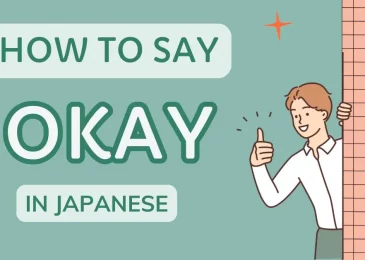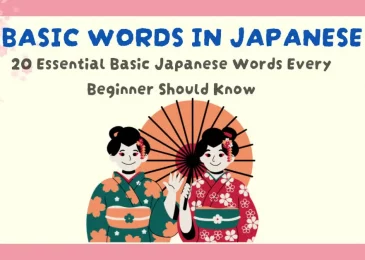In Japanese culture, apologies carry deep meaning and are an essential part of social interactions. Saying “sorry” in Japanese is not just about admitting fault; it’s a reflection of respect, humility, and the desire to maintain harmony in relationships. Knowing how to apologize appropriately is crucial, as Japanese society places a high value on politeness and social harmony.
This article will guide you through various ways to say “sorry” in Japanese, exploring each phrase’s meaning, formality level, and cultural significance. By understanding these nuances, you’ll be able to apologize in Japanese the right way, showing both respect and cultural awareness.
- The Most Common Ways to Say Sorry in Japanese
- Sumimasen vs. Gomen: When to Use Each One
- Formal Apologies: Gomen Nasai and Moushiwake Gozaimasen
- Other Apology Expressions in Japanese
- Apology Etiquette in Japan: Body Language and Situational Context
- Examples of Apologizing in Real-Life Situations
- Common Mistakes to Avoid When Apologizing in Japanese
- Tips for Learning Japanese Apology Expressions
- Conclusion
The Most Common Ways to Say Sorry in Japanese

There are several ways to say “sorry” in Japanese, each carrying different levels of formality and politeness. Here are the main phrases
Sumimasen (すみません) – A versatile phrase used not only for apologies but also to express gratitude or get someone’s attention. It’s suitable for everyday situations and often conveys a polite, respectful apology.
Gomen (ごめん) – A casual apology used among friends or people with whom you have a close relationship. This is more informal and can be compared to saying “Sorry” in English without too much formality.
Gomen nasai (ごめんなさい) – A more polite version of “gomen,” which is suitable for situations requiring more sincerity and respect. This phrase is commonly used with acquaintances, teachers, and sometimes in formal settings.
Moushiwake gozaimasen /Moushiwake arimasen (申し訳ございません/申し訳ありません) – The most formal and serious apology in Japanese. Often used in business settings or in situations where a deep apology is needed. It’s a way of saying “I am deeply sorry” and expresses significant remorse.

Each of these phrases has a unique place in Japanese society. Knowing which one to use can help you avoid misunderstandings and demonstrate the appropriate level of politeness.
Sumimasen vs. Gomen: When to Use Each One
Both sumimasen and gomen mean apologize, but they have distinct connotations and uses.
Sumimasen – Often used to say “excuse me” or “sorry” in polite settings. It’s the go-to phrase when you accidentally bump into someone, need to interrupt, or want to attract someone’s attention. Sumimasen is polite enough for both formal and informal settings. Additionally, sumimasen can sometimes mean “thank you,” especially when you’re thanking someone who has gone out of their way to help you.
Gomen – A more informal apology, suitable among friends, peers, or family members. Gomen is generally used when the situation is casual and doesn’t require much formality. For example, you might say “Gomen” if you’re late to meet a friend.
Example Sentences:
Bumping into someone in a crowded train: “Sumimasen!”
Arriving late to meet a friend: “Gomen, Okureta” (Sorry, I’m late!)
Using the correct phrase in each situation helps convey the right level of politeness, showing that you respect the other person’s time and space.
Formal Apologies: Gomen Nasai and Moushiwake Gozaimasen
In situations that require more formality, gomen nasai and moushiwake arimasen are appropriate.
Gomen nasai – This is a polite way to apologize, suitable for situations where you want to show respect but aren’t in a highly formal or business setting. You can use it with teachers, elders, or acquaintances to show that you’re genuinely sorry.
Moushiwake gozaimasen – The most formal and serious apology in Japanese. You will hear this phrase in business contexts, especially when a significant error has been made, or in cases where a deep apology is necessary. This phrase is usually paired with a bow, and in some cases, a deep bow (saikeirei) is used to express extreme regret.
Example Sentences:
Apologizing for missing a deadline in a professional setting: “Moushiwake gozaimasen deshita.”
Accidentally breaking something that belongs to a friend’s parent: “Gomen nasai”
These phrases show deep remorse and respect, making them essential for more formal or serious situations.
Other Apology Expressions in Japanese
Japanese has various other expressions for apologies, depending on the situation and context:
Shitsurei shimasu (失礼します) – Literally translates to “excuse me” or “pardon me.” This phrase is often used when entering or leaving a room, especially in formal situations. It’s also used to politely interrupt or excuse oneself.
Osore irimasu (恐れ入ります) – A very polite expression that translates to “I’m sorry for troubling you.” This phrase is commonly used in customer service to express humility and regret.
Warui ne (悪いね) – A casual, friendly way of saying “sorry about that,” often used among friends or close acquaintances. It’s slightly less formal than gomen and is used to express a light apology.
These additional phrases allow for more flexibility in apologizing across various situations, making your language skills more nuanced.
Apology Etiquette in Japan: Body Language and Situational Context

In Japan, apologies are often accompanied by body language, such as bowing, to show sincerity. Here’s a quick guide to the types of bows commonly used when apologizing:
Eshaku (会釈) – A slight bow of about 15 degrees, suitable for casual or less serious apologies. It’s often used with “sumimasen” in everyday interactions.
Keirei (敬礼) – A 30-degree bow, appropriate for more formal apologies in professional settings, often used with “gomen nasai.”
Saikeirei (最敬礼) – A deep, 45-degree bow, showing deep remorse and respect. This bow is often paired with “moushiwake arimasen” in cases of serious apology or business formalities.
These bows add depth to apologies, showing that the person truly regrets their actions. The type of bow reflects the level of respect and humility, emphasizing the importance of maintaining harmony.
Examples of Apologizing in Real-Life Situations
Knowing how to apologize in Japanese is best understood through real-life examples. Here are some scenarios:
Bumping into someone on the street: Use “sumimasen” to quickly apologize.
Being late to a meeting: If it’s a formal meeting, “gomen nasai” or “moushiwake gozaimasen” is more suitable, depending on how serious the delay was.
Apologizing in a business setting: If a significant mistake is made at work, “moushiwake gozaimasen” with a bow shows the appropriate level of remorse and professionalism.
In these situations, using the right apology phrase and tone can help convey respect and sincerity.
Common Mistakes to Avoid When Apologizing in Japanese
When apologizing in Japanese, it’s essential to avoid certain mistakes that can seem disrespectful or insincere:
Using Casual Language in Formal Settings: Avoid using “gomen” with superiors or in professional contexts. Instead, use “gomen nasai” or “moushiwake arimasen” for a respectful tone.
Over-Apologizing: Apologizing too frequently, especially for minor issues, can appear excessive. A single “sumimasen” is often enough for small mishaps.
Misusing “Sumimasen” as “Thank You”: While “sumimasen” can mean both “sorry” and “thank you,” it’s essential to understand the context. Use “sumimasen” for apologies and “arigatou gozaimasu” to express gratitude clearly.
Choosing the Wrong Type of Apology: Using overly formal phrases like “moushiwake arimasen” in casual settings, or informal phrases like “gomen” in formal situations, may seem awkward or disrespectful. Match the phrase to the situation for the best results.
By understanding these nuances, you’ll be better equipped to navigate social situations smoothly.
Tips for Learning Japanese Apology Expressions
If you want to practice Japanese apologies effectively, here are some practical tips:
Use language apps: Apps like MochiKanji have useful vocabulary and phrases, allowing you to practice apologizing in various contexts.
MochiKanji is an application for learning Kanji and Japanese vocabulary that makes use of its unique algorithm and the Spaced Repetition technique. MochiKanji maximizes this method by examining your learning history and sending you automated alerts so you can review vocabulary and Kanji at the time.
Watch Japanese media: Anime, dramas, and movies often showcase different apology expressions, providing real-life context to the language.
Practice with a partner: Language partners or friends can help you practice, correct your pronunciation, and explain when to use each apology phrase.
These tips will improve your fluency and confidence in using Japanese apologies correctly
Conclusion
Understanding and using Japanese apology phrases is more than just knowing the words—it’s about respecting the culture and showing humility. Whether you’re using “sumimasen,” “gomen nasai,” or “moushiwake arimasen,” each phrase conveys a level of politeness and thoughtfulness that’s valued in Japanese society.
By learning these phrases and practicing them in the right contexts, you’ll not only enhance your Japanese language skills but also gain insight into the values of respect, humility, and social harmony that are central to Japanese culture. Remember, a well-placed “sorry” in Japanese can go a long way in building trust and maintaining positive relationships.
This article provides a comprehensive guide to saying “sorry” in Japanese, with cultural insights and practical examples to help readers apply these phrases appropriately.






